2.3 Delft Innovation Model in Use
2.3.1 Introduction
In the use of products and services, the need for new products and services will develop; namely, by using the product, users get good or bad usage experiences. In the case of good usage experiences, they will be loyal to the product and the company or brand that is offering the product; with bad usage experiences, they will look around for better product offerings and maybe change over to other products or brands. However, if a company notices that some of its clients have switched over to the products of innovating competitors, they will probably react by offering better or cheaper products, enabling their former users to switch back to the new offering.
To capture the product innovation process, we developed the Delft innovation model (DIM) for educating designers and engineers (Buijs and Valkenburg, 2005; see Figure 2.3.1). For the history and background of the development of this model, we refer to Buijs (2003). This model of the innovation process is one of the elements of the Delft innovation method. For more details about the overall method, we refer to Buijs (2012). In the circular representation of the Delft innovation model in Figure 2.3.1, it can be seen that the product innovation process bites itself in the tail. It shows the five stages (starting from the top and moving clockwise): (1) product use, then (2) strategy formulation, followed by (3) design brief formulation, then on the 8 o'clock position is the (4) development stage, and finally at 11 o'clock is (5) market introduction.
Figure 2.3.1 The Delft innovation model (Buijs and Valkenburg, 2005). Top area: Product use. Black area: Fuzzy front end. Light grey area: Development stage. Dark grey area: Market introduction
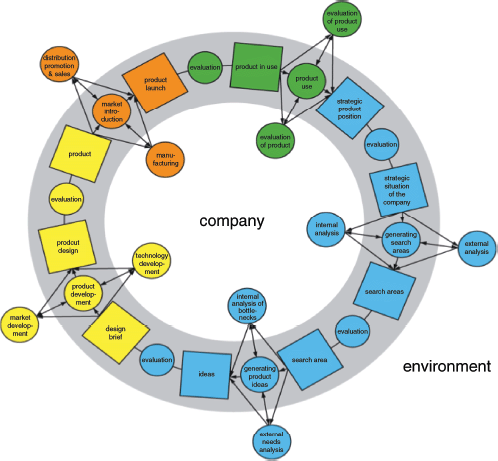
Section 2.3 is structured as follows: In Sections 2.3.2 and 2.3.3, an explication is given about the conceptual model of the innovation process within a company that was built to help practitioners in the field to structure and organize their innovation process. This is followed by Section 2.3.4, which features two practical cases in which master students of the University of Twente show their abilities to apply the model in real-life product innovation cases. Special attention is paid to their struggling with the model: They have to tweak and adjust the model for each specific case, without dumping the main message of the model. This chapter is closed by a meta-reflection by the builder of the model about their playing with his ideas (Section 2.3.5).
2.3.2 Stages of the Delft Innovation Model
The Product Use Stage
The starting point of the product use stage is the product in use (see Figure 2.3.2). This means that the consumers can buy and use the product. Now the product has to fulfill its promises. Does it do what the company, the brand image, and the nice advertisements have been promising? The new product is tested against the real-world competition.
Figure 2.3.2 The product use stage
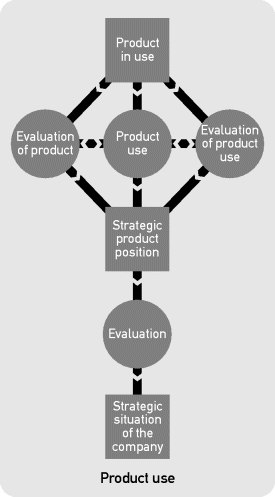
This product Use stage is the most important stage of the product innovation process, but it is also the stage the company has the least influence on. Of course they discovered the original need, they designed the product, and they are responsible for the manufacturing, distribution, and sales, but now the product has to fly for itself. Now it is up to the user to verify all the assumptions and ideas that the company has put into the new product's specifications.
Product use of a new product will lead to a change in the strategic position of the company that is offering the product. The strategic position is the position of the company within its competitive arena.
The strategic position is dependent not only on the company's strategic actions but also on the competition's actions and reactions. Evaluating this change will reveal a new strategic situation of the company, and must ultimately lead to the decision to start a new product innovation process. Figure 2.3.2 summarizes the product use stage.
The Strategy Formulation Stage
The strategy formulation stage should start with external investigations to check and validate the earlier recognized need for innovation in the product use stage. An external analysis cannot be executed from behind your desk. You have to go outside, into the real world. Observe clients, visit shops, talk to consumers, read journals, watch television, be at cool and hot places, and buy and use competitive products.
The reason we have put the three subprocesses parallel to each other is because they are mutually interdependent. What is relevant in the external environment depends on what the company is. The internal analysis influences the external analysis. One of the results of the internal analysis is a judgment about strengths and weaknesses. During the internal analysis, we discover what makes this company unique, what are the strategic strengths, and what are the core competences. Innovating is risky; therefore, it is better to build the innovation on the company's strategic differentiating strengths rather than on resources every company has.
The results of the external analysis and internal analysis are fed into the central process of generating search areas. A search area is a tool to handle the bulkiness of the relevant external world. Up front, we are not able to discriminate what external trends and developments are relevant for a given company. Search areas are combinations of internal company (strategic) strengths with external opportunities. We like to talk about SWOT synthesis because it is a creative activity (Buijs, 1992). It is not just about analyzing objective data; no, it is about formulating data, giving sets of data a new name, and changing the meaning of data by giving them another name.
After the evaluation step, in which the interesting potential search areas are selected, and in which it is checked whether the execution of this stage has been up to expectations, the company can decide to go to the next stage of the innovation process. For a summary of the strategy formulation stage, see Figure 2.3.3.
Figure 2.3.3 The strategy formulation stage
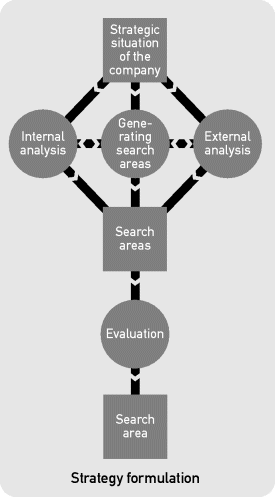
The Design Brief Formulation Stage
In this stage the raw ideas from the chosen search areas have to be transformed into concrete product ideas. Product ideas must be formulated in such a way that a new product development department can start designing the new product.
First we have to find out what internal bottlenecks could prohibit the company from going on with the chosen search area. Internal bottlenecks can be other strategic priorities, conflicting projects, missing knowledge, or other resources. If these bottlenecks look too big, the search area has to be put in the refrigerator, and probably the earlier strategy formulation stage has to be redone (or one of the other chosen search areas has to be investigated).
During the external needs analysis, we are really diving deep into the needs of targeted potential consumers. We are going to visit and talk to our potential clients. We have to find out what really drives people, what needs and wants they have, what they think about competing products, and why they want to spend money on substituting offerings. This is a reality check of the proposed search area.
Based on this external information, the third process can be started: generating product ideas. All kinds of creativity techniques can be used to come up with ideas for new products (see creativity gurus like De Bono, 1985; Gordon, 1961; Osborn, 1957; Rickards, 1974). You need hundreds of ideas to get one implemented. Generating ideas is the core of this stage, and all rules about creativity should be applied.
In the evaluation step, a couple of product ideas will be considered to become the future champions. They have to be formulated in the design brief.
For a summary of the design brief formulation stage, see Figure 2.3.4.
Figure 2.3.4 The design brief formulation stage
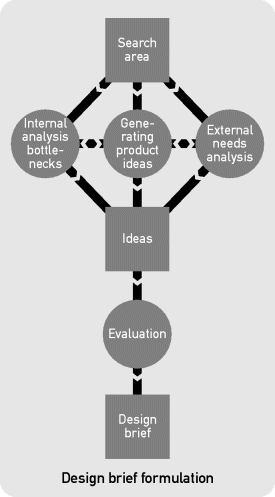
The Development Stage
This is the stage of all traditional product design and engineering activities. The design brief is a starting point, followed by three parallel processes: development process of the product, development of the market, and development of the technology.
The core is product design. Do not forget to wake up the targeted market. It is a new product, so nobody in the marketplace knows anything about it. Great emphasis on marketing and promotion activities is essential for successful innovating companies. The development stage ends with at least working prototypes that probably even have been tested with the potential clients.
Figure 2.3.5 represents the development stage of the DIM.
Figure 2.3.5 The development stage
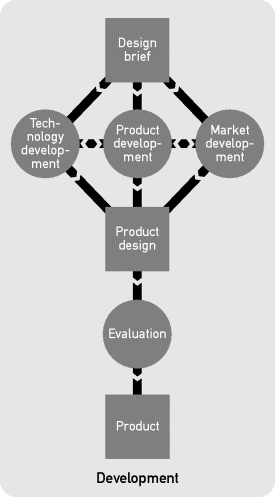
The Market Introduction Stage
This is the final stage of the DIM. This is the last opportunity for the innovating company to actively do something to ensure the wanted qualities of the new product. The core result is the product launch. We refer to this moment as “Steve Jobs in concert,” because Apple has been famous for its new product introduction parties where Steve Jobs used to talk about and show the new product. In Figure 2.3.6 the market introduction stage is summarized.
Figure 2.3.6 The market introduction stage
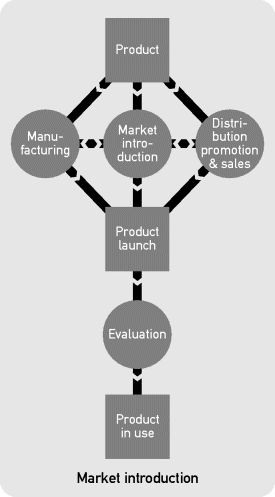
Now the new product is for sale, and next the product use stage (see Figure 2.3.2) can begin, which will close the innovation cycle. This will probably cause a future change of the strategic position of the innovating company and its competitors. The competitive environment is also influenced and changing. The next innovation game will soon be on!
2.3.3 Concluding Remarks on the Delft Innovation Model
As we all know, models are just abstract representations of reality. They mimic only parts of reality, not all of it. With the introduction of the DIM, we want to help companies to improve their innovation activities, but it is not a cookbook. You have to translate our ideas about the innovation process to your own world.
In real life the five stages of the innovation process have different duration times. Product use can be as long as decades, market introduction can be as short as one day, development runs from a couple of weeks to 2–3 years, and design brief formulation and strategy formulation both last a couple of months, but sometimes it can take years to realize and experience the need for innovation. In our model we visualize them as five equal stages, and we suggest that all subprocesses within each stage should be executed jointly, but in reality that is not true.
We want to conclude with some insights based on empirical studies about the product innovation process and relate them to the DIM model. About 30 years ago Cooper tried to get grip on the differences of innovation processes in the real world compared to in theory (Cooper, 1983). He discovered that not all theoretical innovation activities had been used during all innovation processes (apparently you can sometimes skip certain actions). Also he noticed different time patterns within the innovation process. From 1980 to 1987, we executed a large empirical study (the so-called Pii study) inside companies using an earlier version of the DIM model (Buijs, 1984, 1987). We also revealed different time patterns over the different stages of the innovation process. In 2008 we published another empirical study on different innovation patterns (Buijs, 2008). Complex projects (e.g., with new technology and/or a new client) need more activities in the first stages, and also different activities than in noncomplex projects. We also found that innovation leaders adapt an opportunistic attitude toward carrying out activities in parallel in order to gain time. It appears that project-specific circumstances lead toward skipping steps and adopting different time patterns in various product innovation projects. A possible explanation for these differences between the theoretical way innovation process should be run, and the practical way they are run, is that the theory considers innovation processes, while in practice companies run innovation projects. This could mean, for instance, that in innovation project Q the external analysis is skipped, because the marketing department had just finished a report about changes in the outside world. And the project leader of innovation project Q just grabs this report and uses it. So in the project there was no time spend on the external analysis, although the necessary information became available from another source. Another example could be a company that just acquired a small company because it developed an interesting new technology. Once again in innovation project Z there is no time spent on technology development (see the left-hand circle in Figure 2.3.5), but inside that acquired company other people have spent a lot of time on it. So be aware about this discrepancy between innovation projects in real life and innovation processes according to theory.
2.3.4 Applying the Delft Innovation Model in Real Life
Knowing what to do in the innovation process is one thing, but executing it is another. This section describes two applications of the method by master's-level students in the Industrial Design Engineering faculty of the University of Twente. These projects were done for the Sources of Innovation course, where students were instructed to use a variety of innovation methods in the design of a product.
UV Light for Food Preservation
Van Ettinger and Jansma (2008) applied the DIM to a student design project that required the design of a product using LED technology. This resulted in the design of an ultraviolet (UV)–LED light for food preservation in refrigerators. The DIM was used together with other design methods (innovation journey, platform-driven product development, and innovative design and styling), and the authors describe how they applied various models to their process:
By following this path of innovation methodology, the whole industrial design process is covered. By beginning with the journey, the supporting technology will be examined and the historical aspect of the product becomes clear. With the help of the DIM model, the clarification of the task will be sorted out and also the optimization of the elements.
It appears that they used the DIM for task clarification, once the decision was made to explore food preservation as an outcome of the innovation journey method of the previous phase. This resulted in initial product ideas, for example the use of UV radiation to damage bacteria, and color coding to categorize food types, which were incorporated in the final design. This loosely corresponds to the strategy formulation stage of the DIM, whose starting point in the theoretical model is the strategic situation of the company. There are some differences between the DIM-in-theory and the application by these students in practice. One of the most basic is that there is no “company” for which to conduct an internal analysis in this project. Rather, the students have chosen to analyze the possibilities (strengths) of the technological possibilities and initial concept ideas: “the strength of the idea is the dual effect of controlling the e-coli bacteria (and) . . . color LEDs (to give) an indication to the customer of separating different types of food . . . minimal size . . . low energy consumption.” In contrast to the theoretical model, challenges and weaknesses were given little consideration (although the potential psychological barriers to using UV light with food were noted). Mind maps were used to structure and visualize their DIM approach. These were in two areas, LED lighting and food, and are shown in Figure 2.3.7.
Figure 2.3.7 DIM mind maps (Van Ettinger and Jansma, 2008)
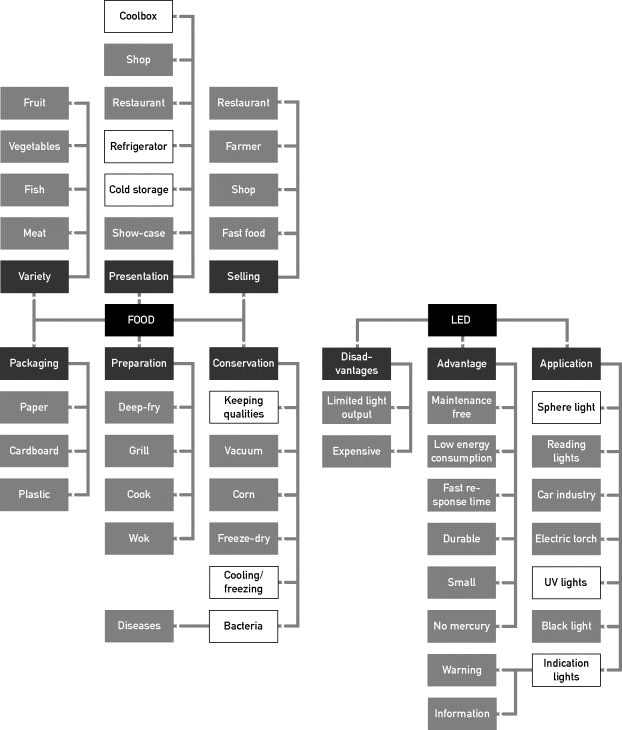
Analysis of these gave the authors the following search areas: sphere and indication light sources, ultraviolet light and radiation, specific cooling systems, and keeping the qualities of food. In the theoretical model, search areas are an input to the design brief stage. In these students' work, it is an input for the platform-driven product development method, where the components needed to implement loose concepts based on the search areas are evaluated.
The resulting product after use of the DIM and other innovation methods is shown in Figure 2.3.8. Details regarding form were developed in later stages, but the fundamental decisions made while applying DIM regarding product function and use were retained.
Figure 2.3.8 Final product (Van Ettinger and Jansma, 2008)
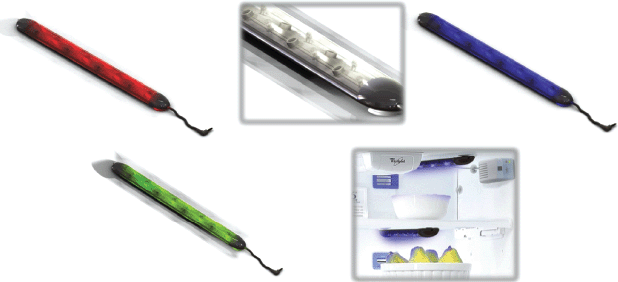
T-Spider Fuel Cell Vehicle
Similarly, students Damkot and de Groot (2006) use the DIM early in the design process for a fuel cell–powered vehicle. The students chose to apply the method “because of its possibilities.... In this project, there is a new technology in a market with opportunities. The DIM Model has the capacity to combine the intrinsic values of technology with opportunities in the market.” Guidelines resulting from their use of the DIM were used as inputs for platform-driven product development.
They used the innovation phase model “to optimally combine the technology with the opportunities in the city.” Two mindmaps were used – one for technology, and another for cities – to visualize and structure their use of DIM.
The authors describe the mind maps shown in Figure 2.3.9 as follows: “Technology contains 4 subgroups; disadvantages, advantages, applications and Design and Styling. City contains 5 subgroups; environment, infrastructure, transportation, opportunities and problems. Transportation is split up into public transport and individual transportation. The used points for the search fields are marked green. There are six market fields and five technical fields” (see Figure 2.3.10).
Figure 2.3.9 Search field selection using mind maps (Damkot and de Groot, 2006)
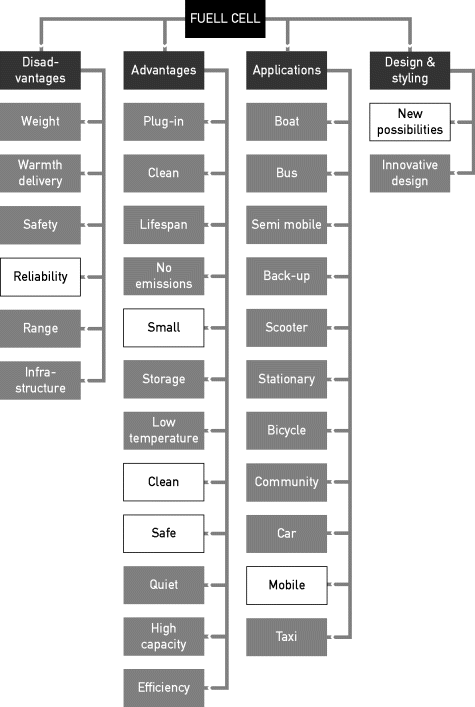
Figure 2.3.10 Search field comparison (Damkot and de Groot, 2006)
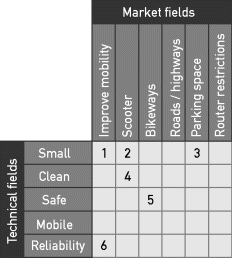
After creation of the individual mind maps, a cross comparison of these technical and market-oriented search fields was made, as shown in Figure 2.3.10. A principal result of this comparison is the decision to design a small vehicle (Figure 2.3.11). As with Van Ettinger and Jansma (2008), the design here is split into different components for consideration in the next stage of platform-driven product development.
Figure 2.3.11 Final product
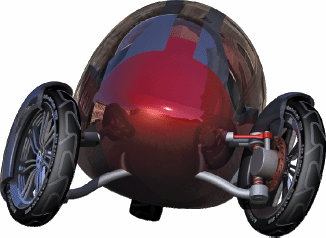
2.3.5 Reflections on the Delft Innovation Model in Practice
It should be noted that there are important differences between the DIM-in-theory and in practice. The student cases described here deal with a speculative situation where both constraints and additional resources are not present or are artificially given.
In a real-world setting, DIM is meant to provide a general approach to the design process rather than strictly prescribe a step-by-step approach. The metaphor of a recipe is given: It is not so much a rigid application of the process that is intended, but rather an understanding of ingredients and their essential qualities, how they interact with each other, what can be substituted or skipped, and how to work with available resources. It is this deeper level of understanding that allows not only for improvisation, but also for greater possibilities for arriving at original outcomes.
The external environment within which innovation takes place is an important consideration. The natural inertia of organizations is to continue with the status quo. Change requires energy and is often disruptive. This places the main driving force for innovation in the external environment: such as the activities of competitors, technological developments, or access to new markets. This external location for the stimulus to innovate is another source of differentiation between applying the DIM in education and in practice. One of the educational implications is that while the real world cannot be perfectly modeled, it is important for instructors to try to approximate some of its critical elements in developing cases, and for students to be clear about assumptions they make regarding the context of their projects.
